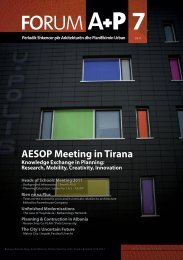Forum A+P 08
POLIS University publishes the “Forum A+P” journal, the only scientific and cultural magazine in the Albanian –speaking countries for the fields of architecture and territory planning. This magazine is recognized by the Ministry of Education and Science, the Academic Degrees Evaluation Committee and has an ISSN international registration code in France. The magazine is published in Albanian and English language and contains a package of scientific, informative articles and analysis.
POLIS University publishes the “Forum A+P” journal, the only scientific and cultural magazine in the Albanian –speaking countries for the fields of architecture and territory planning. This magazine is recognized by the Ministry of Education and Science, the Academic Degrees Evaluation Committee and has an ISSN international registration code in France. The magazine is published in Albanian and English language and contains a package of scientific, informative articles and analysis.
- No tags were found...
You also want an ePaper? Increase the reach of your titles
YUMPU automatically turns print PDFs into web optimized ePapers that Google loves.
Debate në Arkitekturë<br />
Two different ways to be<br />
successful as an architect<br />
Raimund Fein<br />
As architects, we live in a very lucky period: Not<br />
that there is work for everybody anywhere; nor has<br />
our daily work become less stressful, complex and<br />
demanding.<br />
All this is obviously not the case. But there<br />
is something else that seems to be changing:<br />
Architecture, maybe for the first time ever, is rapidly<br />
becoming a topic of public interest. Newspapers<br />
write about questions of architecture, exhibitions<br />
of architecture find a lot of interest, TV offers<br />
programs on architecture. Architecture is discussed<br />
publicly. The public wants to know what we are<br />
doing, what is happening in architecture.<br />
No longer is it possible for architects to<br />
discuss architecture only among each other, to<br />
aim mostly at their fellow experts’ recognition, to<br />
lock themselves into a sort of Ivory Tower. We<br />
are being chased out of the Ivory Tower in which<br />
we have been staying for too long, from where we<br />
have been looking down at those poor mortals who<br />
do not understand our sophisticated and abstract<br />
discussions. It seems that today, more than ever<br />
before, to be successful and recognized, you have<br />
to look for applause among the non-architects. In<br />
short: Architecture seems to become a matter of<br />
mass culture, of popular interest. It has somehow<br />
arrived in the common people’s mind.<br />
Wonderful, we could say; finally the people<br />
are interested in what we are doing. And hasn’t<br />
it always hurt a bit that we had our discussions<br />
only among us, far away from the limelight? Isn’t<br />
it good news that this seems to be over, and isn’t<br />
this a wonderful chance?<br />
Yes, it is. But we, as architects, have to<br />
decide how to go about this situation. Basically,<br />
I can see two ways to react. These two different,<br />
rather opposed ways are what I would like to look<br />
at for a moment, because one of the two ways to<br />
reach the public seems to me a short and rather<br />
easy but a dangerous one; the other one appears as<br />
long, hard and difficult, but maybe more serious.<br />
The first way, the quick and easy one, is<br />
to adapt to the phenomena of mass culture by<br />
allowing the elements of show effect, fashion and<br />
star cult into architecture. All one has to do is to<br />
offer a visual surprise with each design, to offer<br />
something that has been unseen before. To allow<br />
architecture to have a visual impact, it is sufficient<br />
to limit the effect to the surface. It is like when<br />
someone is putting new clothes on a puppet each<br />
time the season and the fashion changes, without<br />
ever changing the puppet itself. In fact, you don’t<br />
have to change the puppet; you can use it over<br />
and over again. Only the surface changes; in this<br />
case, it is only the dress that counts, what makes<br />
the effect and what eventually sells.<br />
The same happens in architecture when it<br />
is seen as a fashion object that is there to fulfill<br />
188





